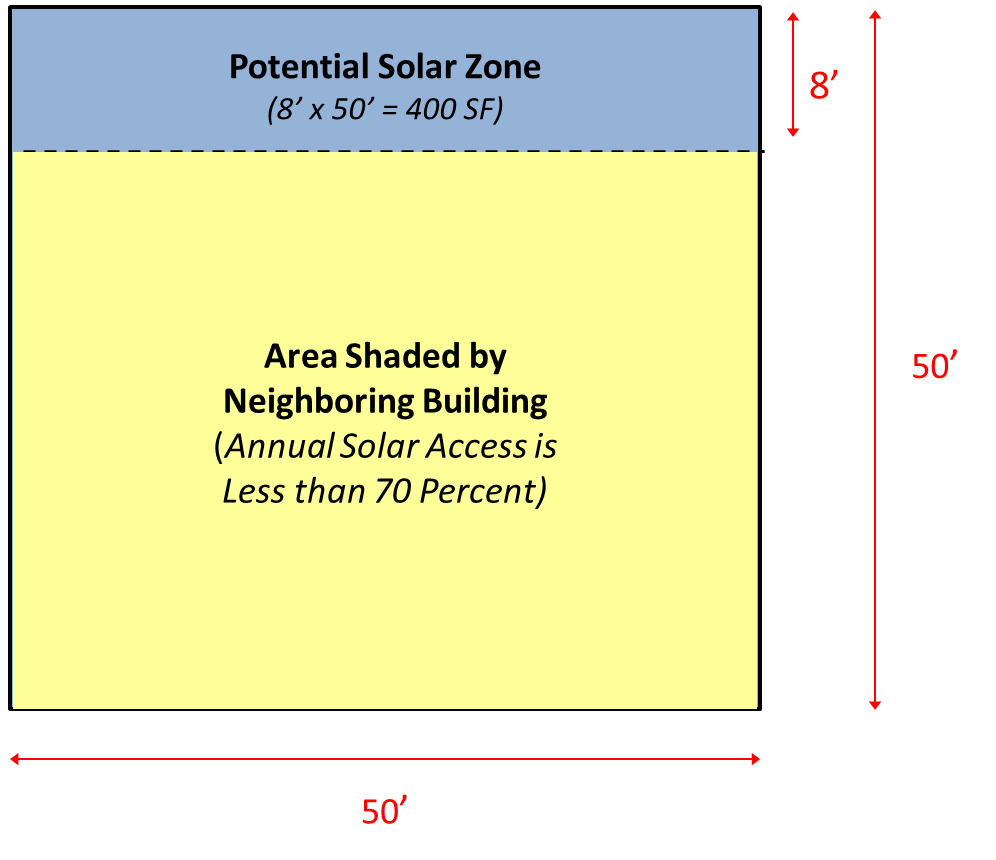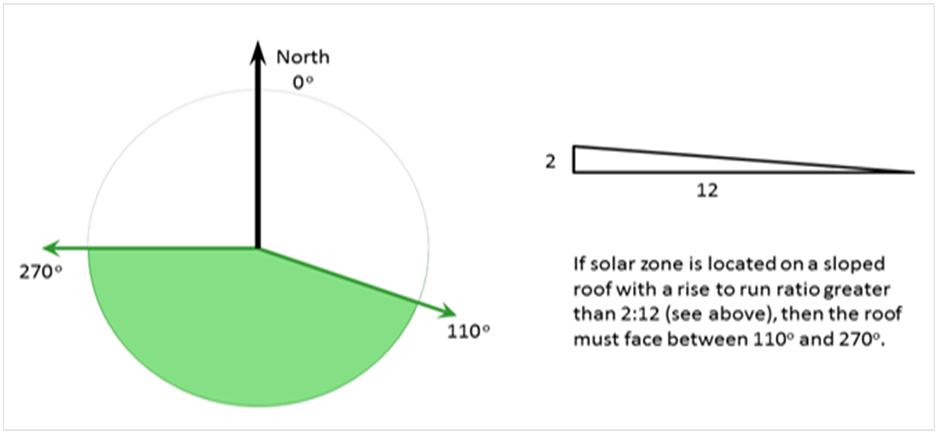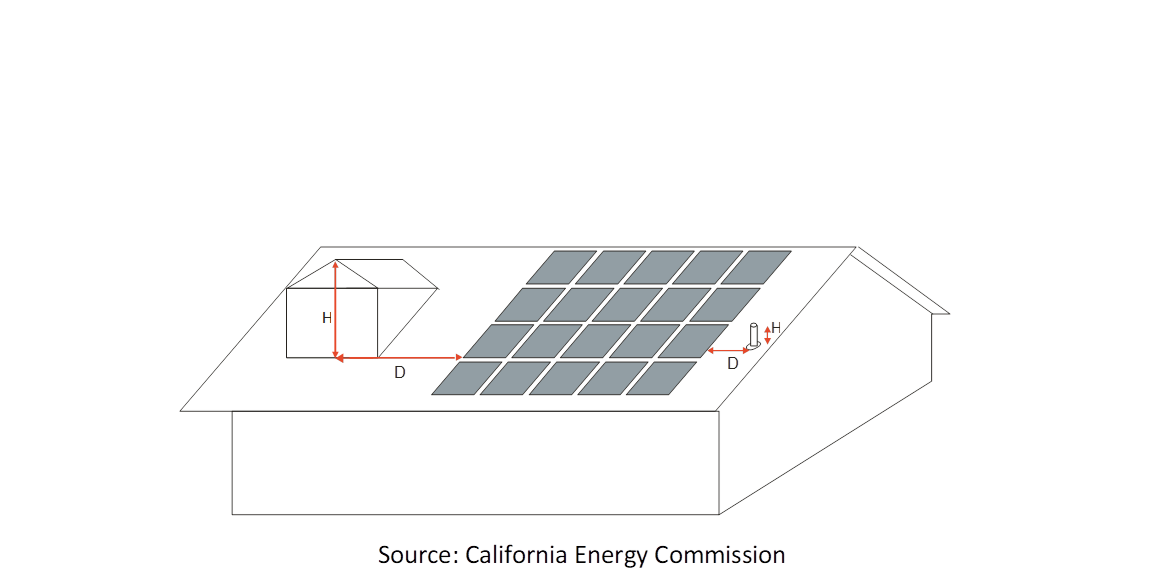
The solar zone is an allocated space that is unshaded, unpenetrated, and free of obstructions. It serves as a suitable place that solar panels can be installed at a future date.
For single-family residential building the solar zone shall be located on the roof or overhang of the building.
For low-rise multifamily buildings the solar zone can be located at any of the following locations:
1. Roof of building
2. Overhang of the building
3. Roof and overhang of another structure located within 250 feet of the primary building
4. Covered parking installed with the building project
5. Other structures include, but are not limited to, trellises, arbors, patio covers, carports, gazebos, and similar accessory structures.
The solar zone design must comply with the access, pathway, smoke ventilation, and spacing requirements as specified in Title 24, Part 9 or in any requirements adopted by a local jurisdiction. These additional requirements are located in other Parts of Title 24 including Parts 2, 2.5, and 9 that are adopted by the California Building Standards Commission as part of the California Building Standards Code.
The total area of the solar zone may be composed of multiple subareas. No dimension of a subarea can be less than five feet. If the total roof area is equal to or less than 10,000 square feet, each subarea must be at least 80 square feet. If the total roof area is greater than 10,000 square feet, each subarea must be at least 160 square feet.
The solar zone shall be located on the roof or overhang of the building. The solar zone shall have a total area that is no less than 250 square feet. There are multiple exceptions, as described below, to the required total solar zone area. For Exceptions A, B, and G below, although the language in the Energy Standards implies that these three exceptions apply only to the solar zone requirements, the intent of the Standards is for the exceptions to apply to the solar zone requirement, as well as the interconnection pathway requirements described in §110.10(c)), the documentation requirements described in §110.10(d). and the electric service panel requirements described in §110.10(e).)
Exceptions:
A. Single-family residential buildings are exempt from the solar zone, interconnection pathway, and documentation requirements if a solar PV system with a nameplate direct current (DC) power rating of 1000 watts or greater is permanently installed at the time of construction. The nameplate rating must be measured under standard test conditions. The permanently installed solar electric system is not required to be on the roof of the building. To verify compliance with this exception, form CF2R-SPV-01-E Certificate of Installation: Photovoltaic Systems must be submitted.
B. Single-family residential buildings are exempt from the solar zone, interconnection pathway and documentation requirements if a domestic solar water-heating system is permanently installed at the time of construction. The SWH system must comply with the installation criteria in the Reference Residential Appendix RA4.4.21 and have a minimum solar savings fraction of 0.50 (the fraction of domestic hot water demand provided by a solar water heating systems) permanently installed at the time of construction. This is the equivalent of the prescriptive solar water-heating system requirements when installing an electric-resistance storage or instantaneous water heater serving a dwelling unit. The permanently installed domestic solar water-heating collectors are not required to be located on the roof of the building. To verify compliance with this exception, form CF2R-STH-01-E Certificate of Installation: Solar Water Heating System must be submitted.
C. The solar zone may be reduced to no less than 150 square feet for single-family residential buildings with three stories or more and with a total floor area equal to 2,000 square feet or less.
D. The solar zone may be reduced to no less than 150 square feet for single-family residential buildings with a whole-house fan and where the building is located in Climate Zones 8 through 14 and where the residence is located in the Wildland-Urban Interface Fire Area (as defined in Title 24, Part 2). This exception is to accommodate attic- and roof-venting requirements in these fire areas.
E. The solar zone may be reduced to 50 percent of the potential solar zone area. For the Energy Standards, the potential solar zone area is the total area of the roof where annual solar access is 70 percent or greater. This exception reduces the required solar zone area when the roof is shaded by objects that are not located on the roof or any other part of the building. If the potential solar zone is smaller than the minimum solar zone area specified in §110.10(b)1A of 250 square feet, then the solar zone can be reduced to half the area of the potential solar zone. If the roof is shaded such that there is no potential solar zone area, then no solar zone is required.
For the solar ready requirements, solar access is the ratio of solar insolation including shading to the solar insolation without shading.

Objects that are excluded from the building project are objects that will not be moved or modified as part of the building project and include existing buildings, telephone poles, communication towers, trees, or other objects. Objects that are included in the building project are objects that will be constructed as part of the building project and include the building itself, HVAC equipment on the building, parking lot lights, and other similar objects. As mentioned, solar access does not take into account shading from objects that are included in the building project as the designer has control of the location of these potential obstructions.
Annual solar access is most easily determined using an instrument equipped with a camera with a fisheye lens and specialized imagery processing software. The instrument can calculate the annual solar access of any point on a proposed site based on the location of the building and information that is captured in the digital photograph. Since this type of instrument relies on photographs, the most appropriate use is to determine solar access on existing buildings. The instruments are not as useful in the design phase for newly constructed buildings, when capturing a digital photograph from the proposed solar zone location is not feasible.
To determine the annual solar access during the design phase, designers will first evaluate whether there are any objects outside the building project that will shade the rooftop (or other prospective solar zone areas such as overhangs or parking shade structures). If an existing object is located north of all potential solar zones, the object will not shade the solar zone. Similarly, if the horizontal distance (“D”) from the object to the solar zone is at least two times the height difference (“H”) between the highest point of the object and the horizontal projection of the nearest point of the solar zone, then the object will not shade the solar zone (See Figure 7-2).
If objects external to the building project could shade the solar zone, annual solar access can be quantitatively determined using several computer-aided design (CAD) software packages that can import a CAD file of the building and perform a shading analysis or several online solar quoting tools can be used that make use of both overhead and orthogonal aerial imagery. Annual solar access can be qualitatively determined using several three-dimensional modeling programs. The method/tools used to quantify that the solar access is less than 70 percent (and reduce the potential solar area) shall be documented in compliance form CF1R-SRA-02-E.
Example 7-1
Question
A house has a total roof area of 2,500 SF. The neighbor’s house and trees shade the roof, so 2,100 SF of the roof has less than 70 percent annual solar access. How big does the solar zone have to be?

Answer
If the entire roof were to have an annual solar access of 70 percent or greater, the minimum solar zone would have been 250 SF. Since the potential solar zone is only 2,500 – 2,100 = 400 SF, however, the minimum solar zone can be reduced to 50 percent of the potential solar zone, or 200 SF.
F. The solar zone may be reduced to no less than 150 square feet if all thermostats in the residential building are occupant-controlled smart thermostats (OCST) with communications capabilities enabled to receive and respond to demand response signals. An OCST is a setback thermostat with communication capabilities that enable the occupant to receive demand response-related messages and respond to those signals by automatic adjustment of the thermostat setpoint as described in Joint Appendix JA5 (subject to occupant participation). Enabling communications capabilities requires that the OCST has one of the following:
•onboard communications capabilities,
•an installed communications module for OCSTs with removable communications module(s), or
•an installed communications gateway for an OCST where an external gateway is required for communications.
G. Single-family residential buildings are exempt from the solar zone, interconnection pathway and documentation requirements if all of the following conditions are met:
1. All thermostats in the buildings are OCST with communications capabilities enabled to receive and respond to demand response signals (subject to occupant participation). Enabling communications capabilities requires that the OCST has one of the following: onboard communications capabilities, an installed communications module for OCSTs with removable communications module(s), or an installed communications gateway for an OCST where an external gateway is required for communications.
2. One of the following measures shall be met:
a. Install a dishwasher that meets or exceeds the ENERGY STAR® program requirements and install either a refrigerator that meets or exceeds the ENERGY STAR program requirements or a whole-house fan driven by an electronically commutated motor; or
b. Install a home automation system capable of, at a minimum, controlling the appliances and lighting of the dwelling and responding to demand response signals; or
c. Install alternative plumbing piping to permit the discharge from the clothes washer and all showers and bathtubs to be used for an irrigation system in compliance with the California Plumbing Code; or
d. Install a rainwater catchment system designed to comply with the California Plumbing Code and use rainwater flowing from at least 65 percent of the available roof area
The solar zone shall be located on the roof or overhang of the building or on the roof or overhang of another structure located within 250 feet of the building or on covered parking installed with the building project. Other structures include, but are not limited to, trellises, arbors, patio covers, carports, gazebos, and similar accessory structures. The solar zone shall have a total area that is no less than 15 percent of the total roof area of the building after subtracting any skylight area from the roof area. There are multiple exceptions, as described below, to the required total area. For Exceptions A, B, D, and E below, although the language in the Energy Standards implies that these four exceptions only apply to the solar zone requirements, the intent of the Energy Standards is for the exceptions to apply to the solar zone requirement as well as the interconnection pathway requirements described in §110.10(c), and the documentation requirements described in §110.10(d).
Exceptions
A. Buildings are exempt from solar zone, interconnection pathway, and documentation requirements if a solar electric system with a nameplate DC power rating of no less than 1 watt per square foot of roof area is permanently installed at the time of construction. The nameplate rating must be measured under standard test conditions. The permanently installed solar electric system is not required to be located on the roof or overhang of the building or on the roof or overhang of another structure. To verify compliance with this exception, form CF2R-SPV-01-E Certificate of Installation: Photovoltaic Systems must be submitted.
B. Buildings are exempt from solar zone, interconnection pathway, and documentation requirements if a domestic solar water-heating system complying with §150.1(c)8Biii is permanently installed at the time of construction. This is the equivalent of the prescriptive solar water-heating system requirements when installing a water-heating system serving multiple dwelling units. The permanently installed domestic solar water-heating collectors are not required to be located on the roof or overhang of the building or on the roof or overhang of another structure. To verify compliance with this exception, form CF2R-STH-01-E Certificate of Installation: Solar Water Heating System must be submitted.
C. The solar zone may be reduced to 50 percent of the potential solar zone area. The potential solar zone area is the total area of the roof where annual solar access is 70 percent or greater. This exception reduces the required solar zone area when the roof is shaded by objects that are not on the roof or any other part of the building. If the roof is shaded such that there is no potential solar zone area, then no solar zone is required.
D. Low-rise multifamily buildings that comply with items 1 and 2 below are exempt from solar zone, interconnection pathway, and documentation requirements.
1. All thermostats in each dwelling unit are occupant controlled smart thermostats (OCST) with communications capabilities enabled to receive and respond to demand response signals. An OCST is a setback thermostat with communication capabilities that enable the occupant to receive Demand Response related messages and respond to those signals by automatic adjustment of the thermostat setpoint as described in Joint Appendix JA5 (subject to occupant participation). Enabling communications capabilities requires that the OCST has one of the following: onboard communications capabilities, an installed communications module for OCSTs with removable communications module(s), or an installed communications gateway for an OCST where an external gateway is required for communications. OCST must be certified by the Energy Commission to meet the requirements described in the Joint Appendix JA5.
2. For each dwelling unit, one of the following measures shall be met:
a. Install a dishwasher that meets or exceeds the ENERGY STAR program requirements and install either a refrigerator that meets or exceeds the ENERGY STAR program requirements or a whole-house fan driven by an electronically commutated motor; or
b. Install a home automation system capable of, at a minimum, controlling the appliances and lighting of the dwelling and responding to demand response signals; or
c. Install alternative plumbing piping to permit the discharge from the clothes washer and all showers and bathtubs to be used for an irrigation system in compliance with the California Plumbing Code; or
d. Install a rainwater catchment system designed to comply with the California Plumbing Code and use rainwater flowing from at least 65 percent of the available roof area.
E. Buildings are exempt from solar zone interconnection pathway and documentation requirements if the roof is designed for vehicle traffic (parking lot) or if the roof is designed as a helicopter landing zone
For both single family residential and low-rise multifamily buildings, all sections of the solar zone on steep-sloped roofs (ratio of rise to run of greater than 2:12) shall be oriented between 110 degrees and 270 degrees of true north. The orientation is important because it ensures a reasonable solar exposure if a solar energy system is installed in the future.

If a solar zone is located on a low-sloped roof (ratio of rise to run of 2:12 or less), the orientation requirement does not apply.
For both single-family residential and low-rise multifamily buildings, the solar zone shall be free from roof penetrations and shall not have any obstructions such as vents, chimneys, architectural features, or roof-mounted equipment located in the solar zone. This requirement ensures that the solar zone remains clear and open for the future installation of a solar energy system.
For both single-family residential and low-rise multifamily buildings, any obstruction located on the roof or any other part of the building that projects above the solar zone shall be located at a sufficient horizontal distance away from the solar zone in order to reduce the resulting shading of the solar zone. For each obstruction, the horizontal distance (“D”) from the obstruction to the solar zone shall be at least two times the height difference (“H”) between the highest point of the obstruction and the horizontal projection of the nearest point of the solar zone (see following equation).
Equation
7.1
D ≥2 X H

Any obstruction oriented north of all points of the solar zone is not subject to these requirements. Any obstruction that is not located on the roof or another part of the building, such as landscaping or a neighboring building, is not subject to these requirements.